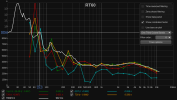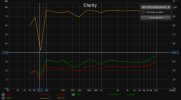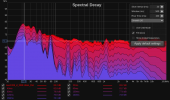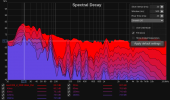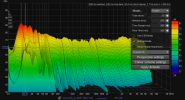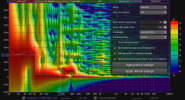These look great, and thanks so much for sharing your before and after measurements and listening impressions!
Sorry if I'm being daft, but don't the MDF slats primarily serve as diffusers rather than absorbers? And if so, doesn't their standardized/non-random orientation and depth make them rather poor diffusers? Not trying to criticize the OP, just asking.
As for the rest of the absorption discussion, I'd say that like any room treatment discussion, it's really multiple discussions.
First, flutter echo, or the perception of excess reverb/liveness in the midrange and lower treble frequencies we humans are most sensitive to, is probably the most extreme and worst acoustic problem. But it's also the easiest to treat. Pretty much any kind of room treatment - thick absorber, thin absorber, homemade diffuser, bookshelf with books, carpet/rug, curtains, furniture, wall hangings - is going to instantly reduce or eliminate the extreme reflections and resonances at those higher frequencies.
Second, as
@Puddingbuks notes - and as many of
@amirm 's speaker review measurements show - ceiling and floor absorption is arguably more important than anything else, and again it's pretty easy. Any old floor covering is going to make a major difference compared to a wood floor. (I see the OP already has a rug; again, this is not directed at the OP, just a general statement.) And while those $20 homemade ceiling panels are great, you don't need to cover all or most of the ceiling with panels to make a big difference. I have only two ceiling panels, albeit rather thick ones, mounted more or less halfway between my speakers and my listening position, and no measurements are necessary to tell if they have an effect. The entire room is nicely controlled (well, above about 200Hz anyway) and not "live" overall, but when you are sitting in the couch at the listening position and go to say something to the person sitting next to you, it's almost like you're listening to the inside of your own head - there's just no echo, and the effect on the perception of soundstage precision is obvious to everyone who's ever sat there and listened to the system.
Finally, as many have noted, dealing with reflections and resonances below about 300-350Hz - the range where it becomes more about the room than the speaker - is a whole other enterprise and it requires care in speaker placement and, if you are going to use room treatments, some pretty darned thick treatments covering a pretty darned decent percentage of the room's surfaces, especially corners. In my case my room has significant space constraints when it comes to placing corner absorbers on the rear wall. So I make do with thick absorbers at the front-wall corners, and homemade 6-inch thick absorbers with another 4” of airspace behind them at the middle of the rear wall (rock wool insulation wrapped in black fabric and inserted into Ikea Billy bookcases). If I go to either rear corner of the room, there's instantly more bass. But no one would ever stand in those corners to listen to music, and from the listening position it's fine so overall I can live with it; most of us have to make do with what we have, and if we have a pleasant listening space and a nice system we are already so fortunate.


